Innovation Drives Sustainable Development
By XU LIANG
TEN years have passed since the Chinese government first proposed the idea of building an innovative country back in January 2006. The government has set the goal of “establishing an innovative country by 2020 in which science and technology will be the main buttress for social and economic development.” What achievements have we made in new technology, new industry and new modes of business? How do we assess the progress? The overall characteristics, I think, are a benign institutional environment and smooth policy implementation.
Large-scale Input
In the last decade China has invested heavily in new technology and new industry. This year R&D expenditure as a percentage of GDP is set at above two percent. As of the end of 2015, the contribution of science and technology to the economy rose to 55.1 percent, closer to the original target of 70 percent. China has even begun to take the lead in some fields. A range of indicators show that Chinas dependence on foreign technology is in gradual decline and displays a substantial increase in economic output driven by domestic innovation.
Large-scale investment reflects the institutional advantage of China that allows it to pool the resources of governments at all levels for major undertak- ings. Evidently, the new economy, which encompasses the innovative and green economy, has boosted the countrys development, and secured its transition to the path of sustainable development.
The industries that have achieved great progress include Internet finance, cloud computing, the Internet of Things, e-commerce, intelligence industry, aviation, and aerospace. A collection of frontier technologies, such as industrial robots, 3D printing, new energy vehicles, and the Nth party logistics, have also grown fast. These industries have received policy support, with some industries classed as strategic being given top priority.
In recent years top Chinese leaders have advocated “mass entrepreneur-ship” and the “new normal”of economic restructuring, which ignite public participation and create a benign environment for the sustainable development of new industry and new technology. Furthermore, emerging new industries have become more standardized during the current second decade of the 21st century. This, in turn, has laid the foundations for making and implementing policies and measures for their orderly, healthy development.
Take Internet finance for example. This year is called the first year of standardization. It has witnessed a deluge of transactions in line with the direction of innovation, and compliance with rules, so benefiting all.
Economic Transformation Opportunity
Compared with 20 years ago, China is formulating more stringent policies and stronger measures to force high-polluting entrepreneurs to shed outdated production capacity. This reflects the resolution of the Chinese government to push forward the economic transition via currency, financial and restructuring policies.
Following the second industrial revolution, Germany grew faster than the U.K., as it adopted newer technologies whilst the U.K. remained entrenched in ones which were increasingly obsolete. This historical anecdote reminds us that in order to upgrade the economic structure it is first imperative that outdated capacity be abandoned. Injecting vigor can achieve an economy and society orientated towards innovation. In this sense, cutting out-dated and excessive capacity will strengthen the “sustainable elements” and reduce the uncertainties of innovative development.
New industry and new technology represent the hope of Chinas economic restructuring and upgrading. For instance, WeChat, an instant message app unveiled in early 2011, as of the first quarter of 2015, the app had been installed in over 90 percent of smart phones in China, with active users per month reaching 549 million in about 200 countries and more than 20 languages. Whats more, WeChat has over eight million official accounts, about 400 million paying users, and docks with 85,000 apps. It has become a platform for international finance, ecommerce, and modern logistics, attracting an increasing flow of business and capital.
Catching up
Along with a rising confidence in innovation, China is taking a leading position in new industries and new technology. In the first 30 years after the beginning of reform and opening-up, China had been the factory of the world, but largely at the lower end of the industrial chain. Now it is constructing an innovative country, striving to be more competitive, higher up the chain, as well as a power that can change the world for the better. American historical social scientist Immanuel Wallerstein, founder of the world systems theory, claims that China is undoubtedly a core nation.
Chinas innovative impetus is rooted in its economically backward status well within living memory as well as the diligent and pragmatic nature of its culture. When Chinas first unmanned spacecraft, Shenzhou-1, launched at dawn on November 20, 1999, people flocked to the streets, and news extras were all sold out. Nowadays, Chinese scientists possess enhanced confidence and spare no effort in catching up with Western countries that formerly maintained a long period of technological superiority. The private sector, well known for its industriousness and entrepreneurship, has maintained its forging momentum. And Chinese people, especially intellectuals, also keep striving for innovation and development, inspired by patriotism. All this contributes to the cultural foundation of the countrys sustainable development.
Chinas capacity for innovation has also enabled it to challenge the old international order and world pattern, making international institutes and rules treat developing countries more fairly.
Take the aviation and aerospace technology, for example. On January 11, 2007, China launched the KT-1 rocket with a kinetic warhead to conduct an anti-satellite intercept test with a speed of eight km per second in the opposite direction. The rocket successfully hit a decommissioned 750-kg meteorological satellite at an orbital altitude of 863 km, the first successful case since the U.S. launched ASM-135 anti-satellite missile in a similar test in 1985. The progress made in this field has greatly increased the self-confidence and sense of security of the Chinese people.
The world also focused on the new weapons unveiled in the Chinese military parades of 2009 and 2015. In space industry, military science, and other fields less known to the public, China is growing through the strength of innovation and is now entering a phase of sustainable development.
The reform and opening-up policy China adopted roughly 40 years ago brought changes to its institutional structure, but also kicked off a local industrial revolution. In the second decade of the 21st century, the country is undergoing another industrial revolution, that of the information age. For China, these two revolutions have also been a process of learning from the U.S.
In the early years of reform and opening-up, China completed its industrialization, imported advanced technologies and modeled itself on Western countries. In the new century, however, more innovative creations have emerged in China, thanks to improved public education, increasing numbers of scientists, and the countrys closer integration with the world. In some fields like highenergy physics, quantum mechanics, and gene technology, China leads the world.
Though China is transforming its economy through focusing on technological innovation, industrial upgrading, and green development, it still has a long way to go. As the U.S. has kicked off a revolution fueled by shale oil and a smart transportation network, China needs to continue to reform in a resolute, steady way. As Li Yizhong, former minister of industry and information technology, commented: “The old driving force is waning while the new one is growing. Innovation is becoming the powerhouse of Chinese economy and transforming the pattern of growth.”

